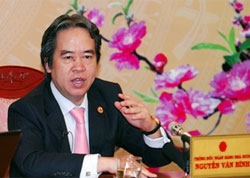Governor: Vietnamese dong increases its attractiveness
 “ Vietnam retained a stable foreign exchange rate and forex market in a difficult context last year. The forex had fluctuated less than 1 per cent,” Binh said at an online discussion held by the Government Web Portal chinhphu.vn in Hanoi on January 12.
“ Vietnam retained a stable foreign exchange rate and forex market in a difficult context last year. The forex had fluctuated less than 1 per cent,” Binh said at an online discussion held by the Government Web Portal chinhphu.vn in Hanoi on January 12.
“Speculation in the foreign currency market had reduced sharply, while people tended to sell foreign currency to banks, thus improving liquidity in the system,” he added.
The online discussion focused on issues of monetary policy, interest, liquidity in the banking sector, restructuring, foreign exchange and gold markets.
Liquidity has been a headache for years. The average credit growth in the banking system was 29.4 per cent over the past 10 years, he said.
Besides, capital utilisation structure at banks was incorrect because they mobilised money for the short term while loans were mid- and long-term, he said.
The SBV regulates that the rate of mid and long-term loans at every bank should be less than 30 per cent. However, in reality, the rate was 60-70 per cent, or even 100 per cent, of banks’ total loans.
“Credit institutions coped with difficulties when the Government implemented tighter monetary policies,” he said, adding that the SBV and commercial banks were finding solutions for a lower interest rate at a suitable level.
At the discussion, the governor affirmed that the country has not yet had enough conditions to lower the interest rate in the banking sector.
The lower interest rate is the urgent demand of people as well as hope of the Government and banks.
“However, lowering it depends on several conditions, including inflation and liquidity at banks,” he said.
The governor said the country saw a high inflation of 18.5 per cent for 2011 despite CPI’s growth rate being reduced.
“We could not lower the interest rate immediately with such as high inflation rate.”
Earlier at a press meeting in Hanoi , Binh said that in the first quarter of the year, the central bank will maintain its interest cap.
“The SBV will supply money to credit institutions to increase their liquidity and facilitate business production activities.”
The cap interest rate at 14 per cent a year was expected to be lifted when the SBV could better manage credit institutions’ liquidity, he said.
Accordingly, the banking sector posted a credit growth of 13 per cent last year, representing almost one-third of the previous years’ figures.
Binh said tightening credit growth will help reduce machinery and equipment imports and the trade deficit.
The central bank will continue supporting Vietnamese dong and stabilising foreign currencies to ensure that exchange rate fluctuation would be held at 2 to 3 per cent.
Several people and organisations were concerned whether there would be a crisis in the banking sector or not.
Binh confirmed that the sector’s restructuring was rooted from the demand to change the country’s economic development model, not its weaknesses.
“A restructuring of the whole economy will improve the quality instead of quantity. It has been an urgent demand to resolve shortcomings in the banking sector,” he said, adding that there will be five to eight banks to be merged this year.
He also admitted that violations in the interest rate cap were prevalent due to a weakness in supervision.
“The SBV has drastically resolved the situation since September, but will promote the supervision this year.”
Binh added that all activities violating SBV’s regulations, including interest rate caps, will be illegal and unhealthy to competition. The SBV will cooperate with public security forces to strictly punish violations.
What the stars mean:
★ Poor ★ ★ Promising ★★★ Good ★★★★ Very good ★★★★★ Exceptional
Related Contents
Latest News
More News
- PM urges Ho Chi Minh City to innovate and remain Vietnam’s economic locomotive (November 26, 2025 | 15:29)
- Experts chart Vietnam's digital finance path: high hopes, high stakes (November 14, 2025 | 10:56)
- Vietnam’s seafood imports surge 30 per cent in first 10 months (November 10, 2025 | 19:35)
- Vietnam’s durian exports hit $1 billion milestone (October 30, 2025 | 17:41)
- Beyond borders: Sunhouse and new era of Vietnamese brands on Amazon (October 28, 2025 | 10:46)
- Record-breaking trade fair set to open in Hanoi (October 15, 2025 | 15:59)
- Timber sector seeks solutions to VAT refunds (October 14, 2025 | 18:58)
- Tether explores investment prospects in Vietnam’s digital asset sector (October 10, 2025 | 18:09)
- Vietnamese investors pour nearly $847 million into overseas markets in nine months (October 08, 2025 | 18:42)
- Vietnam amends Law on Civil Aviation to create drive airport investment (October 03, 2025 | 18:29)

 Tag:
Tag:




















 Mobile Version
Mobile Version